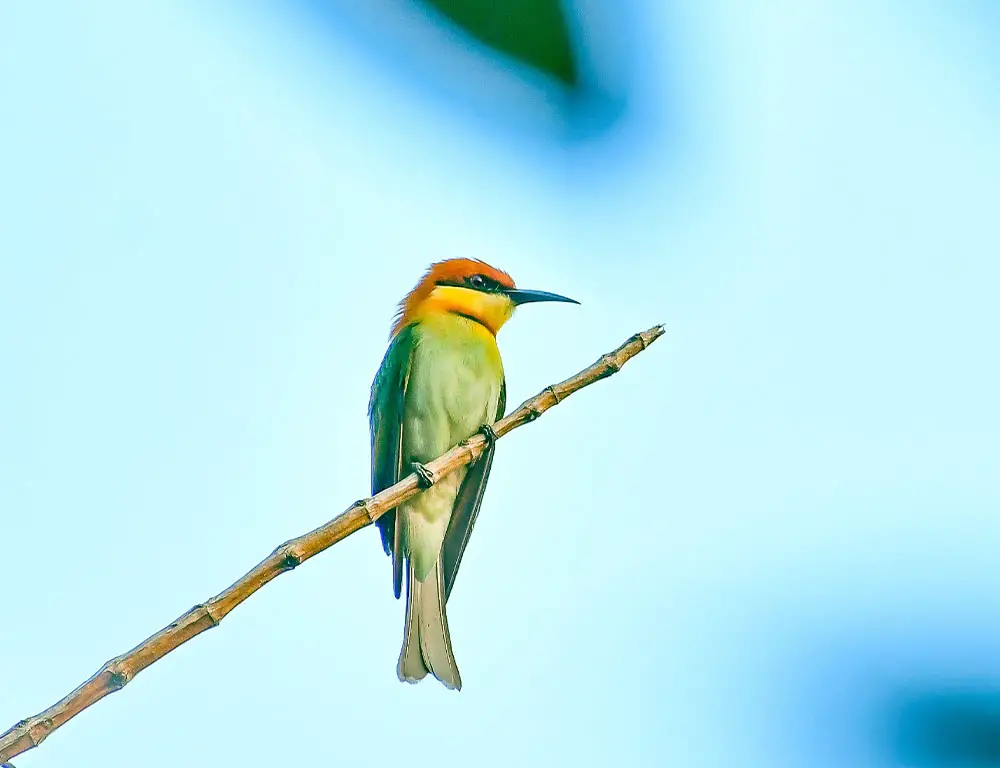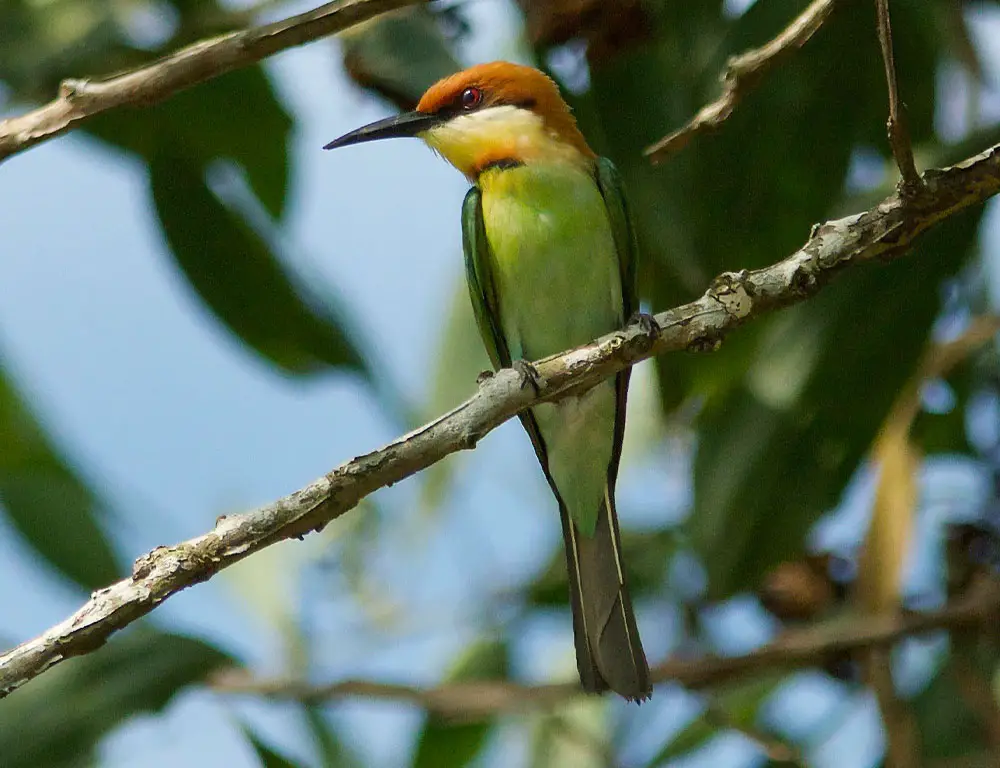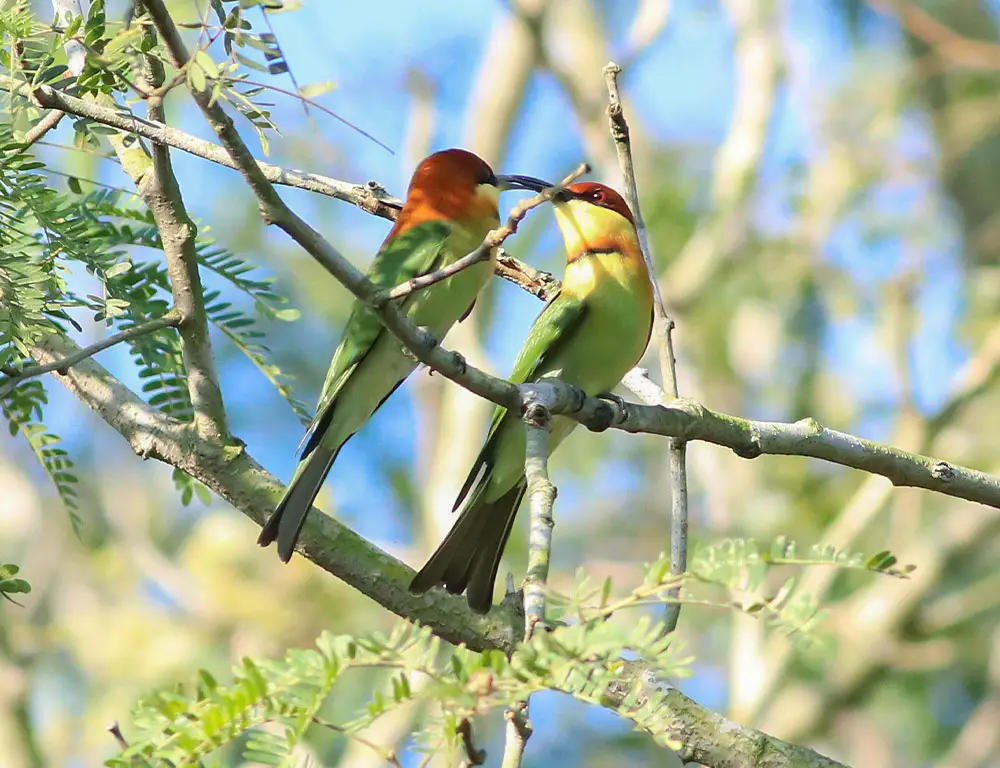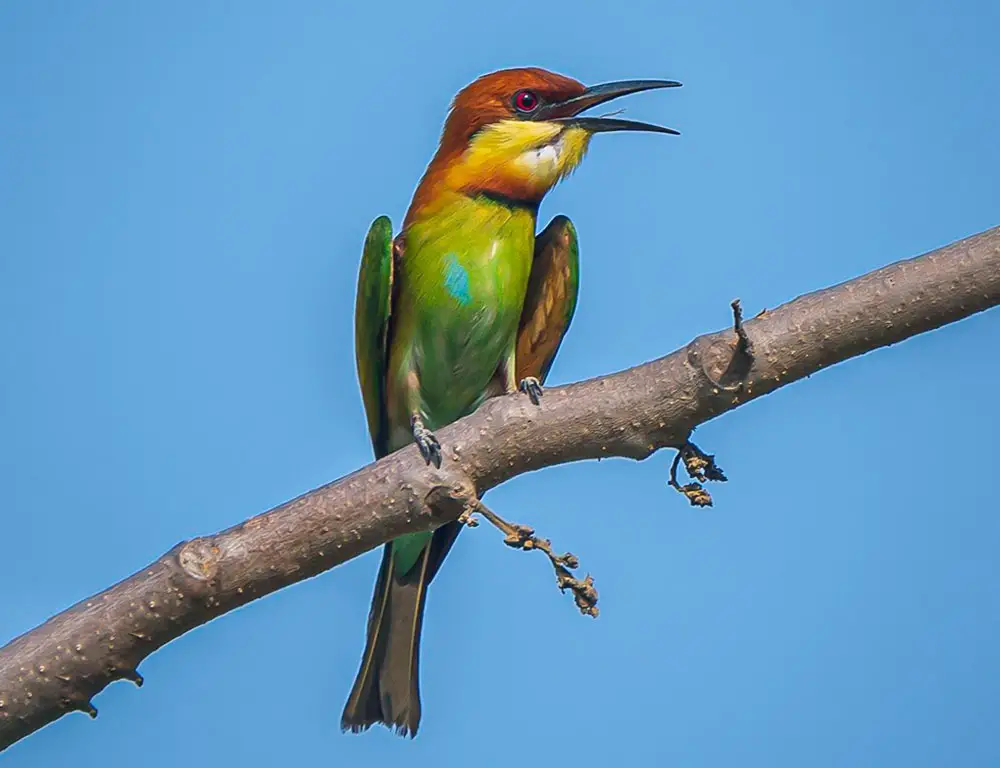Diving headfirst into ornithology, I’ve been captivated by the Chestnut-Headed Bee-Eater. This bird is a true marvel of nature in color and fascinating in its behaviors.
It’s not just its intriguing moniker that grabs your attention; it’s everything from its distinctive appearance to its dramatic feeding rituals that make this species stand out in the avian kingdom.
The Chestnut-Headed Bee-Eater, scientifically known as Merops leschenaulti, belongs to the Meropidae family.
Originating predominantly from South Asia, these birds are admired for their striking colors: an eye-catching blend of chestnut browns, bright greens, blues, and yellows.
Their slender streamlined bodies are complemented by elongated central tail feathers, adding an extra touch of elegance.
But it isn’t solely their aesthetics that have won my admiration; their diet also makes them unique. As you might guess from their name, these birds are expert bee catchers – but they’re not limited to bees alone! They’ll feast on wasps and other flying insects, too.
Observing them dart around with precision in mid-air is quite a sight to behold! Their technique involves catching their prey in flight and returning to a perch where they ‘beat’ the insect until it’s safe to eat – fascinating creatures!
Physical Characteristics of the Chestnut-Headed Bee-Eater

The Chestnut-headed Bee-eater (Merops leschenaulti) is a small, vibrant bird known for its striking colors and slender build.
Here are its key physical characteristics:
Plumage
The Chestnut-headed Bee-eater’s plumage is predominantly a vibrant green color that glistens in the sunlight, giving it a dazzling appearance. This green hue serves as effective camouflage in its lush forest habitats.
Its chestnut brown head and back contrast the green body, aiding in easy recognition.
Size
Despite their vibrant appearance, Chestnut-headed Bee-eaters are relatively small birds, measuring 7 to 9 inches from beak to tail tip. This compact size allows them to maneuver swiftly through dense foliage in pursuit of their insect prey.
Weight
These birds are lightweight, typically weighing between 15 to 20 grams. This low weight contributes to their agility in flight and enables them to perform intricate aerial maneuvers while hunting.
Tail Feathers
One of the most distinctive features of the Chestnut-headed Bee-eater is its long central tail feathers, which extend beyond the rest of its body.
These twin streamers add elegance to their appearance and aid in stabilizing and steering during flight, wildly when darting after flying insects.
Beak
Equipped with a sharp and slightly curved black beak, Chestnut-headed Bee-eaters are adept at catching insects mid-air. The curved shape of their beaks allows for precise and efficient capture of their prey, making them highly successful hunters.
Sexual Monomorphism
Both male and female Chestnut-headed Bee-eaters exhibit identical plumage and physical characteristics, a phenomenon known as sexual monomorphism.
This lack of dimorphism makes it challenging for observers to distinguish between the sexes based on appearance alone.
Vision
Chestnut-headed Bee-eaters possess keen eyesight, facilitated by the placement of their eyes on either side of their tiny heads. This arrangement grants them a wide field of view, allowing them to detect potential prey from afar.
Furthermore, the ability of each eye to move independently enhances their depth perception and tracking abilities, which are crucial for successful hunting escapades.
Habitat and Distribution of the Chestnut-Headed Bee-Eater

The Chestnut-Headed Bee-Eater is a fascinating bird that inhabits diverse subtropical and tropical regions across Asia.
Here’s an overview of its habitat and distribution:
Geographic Range
The Chestnut-Headed Bee-Eater is commonly found across several Asian countries, including India, Nepal, Bangladesh, Bhutan, Sri Lanka, Myanmar, Thailand, Cambodia, and Laos. Its distribution extends throughout the subtropical and tropical zones of these regions.
Habitat Preferences
Despite their name suggesting a preference for bee-rich environments, Chestnut-Headed Bee-Eaters primarily inhabit wooded habitats.
They are often observed darting through the foliage of deciduous forests or hovering around plantations in search of their insect prey.
These birds are adaptable to various altitudes, thriving at sea level up to approximately 2000 meters high.
Nesting Behavior
During the breeding season, typically from March to June, Chestnut-Headed Bee-Eaters exhibit specific nesting preferences. They tend to construct their nests on flat ground or gentle slopes, particularly along river banks or road cuttings.
This nesting behavior is consistent across their range and contributes to their reproductive success.
Conservation Status
While Chestnut-Headed Bee-Eaters are widespread across their preferred habitat range, they face habitat loss and deforestation threats. However, this resilient species demonstrates adaptability and continues thriving in areas with suitable habitats.
Feeding Behavior of the Chestnut-Headed Bee-Eater

The Chestnut-Headed Bee-Eater’s fascinating feeding behavior showcases several remarkable strategies and adaptations.
Here’s an overview of their feeding habits:
Diet Composition
While the name suggests a primary diet of bees, Chestnut-Headed Bee-Eaters consume various insects. Bees comprise approximately 60% of their diet, followed by wasps at 25% and other insects at 15%.
This diverse diet ensures they can access prey items for sustenance.
Hunting Technique
Chestnut-headed bee-eaters employ a unique hunting strategy of capturing prey in flight. They skillfully chase after flying insects, such as bees, wasps, beetles, and dragonflies, and capture them mid-air using their agile flight skills and sharp beaks.
Prey Handling
Once a bee or wasp is caught, the Chestnut-Headed Bee-Eater returns to a perch, beating the insect against the surface until it is stunned or killed. This behavior effectively disables the stingers of bees and wasps, making the prey safer to consume.
Cooperative Hunting
These birds often exhibit cooperative hunting behavior, hunting in pairs or groups. They may take turns chasing after insects, utilizing teamwork to increase their hunting efficiency and success rates.
Selective Prey Choices
Research suggests that Chestnut-Headed Bee-Eaters exhibit selective prey choices, avoiding honeybees laden with pollen. This behavior indicates an ability to discern between different prey items based on nutritional content or ease of digestion.
Conservation Status of the Chestnut-Headed Bee-Eater

The conservation status of the Chestnut-Headed Bee-Eater, while currently listed as “Least Concern” on the IUCN Red List, warrants ongoing attention and proactive conservation efforts.
Here’s an overview of the factors influencing their conservation status:
Habitat Destruction
Like many wildlife species, Chestnut-Headed Bee-Eaters are susceptible to habitat destruction, primarily due to human activities such as deforestation, urbanization, and agricultural expansion.
Loss of suitable habitat can disrupt their nesting sites and foraging areas, ultimately affecting their population dynamics.
Climate Change
The effects of climate change, including rising temperatures and altered precipitation patterns, can impact the availability of resources critical for the survival of Chestnut-Headed Bee-Eaters.
Changes in insect populations, flowering patterns of plants, and overall ecosystem dynamics may pose challenges to their long-term viability.
Human Disturbance
Human activities, including infrastructure development, tourism, and recreational pursuits, can disturb Chestnut-Headed Bee-Eaters and disrupt their natural behaviors.
Encroachment into their habitats may lead to habitat fragmentation, loss, and increased disturbance during critical breeding and nesting periods.
Conclusion
I’ve journeyed with you through the fascinating world of the Chestnut-Headed Bee-Eater, and I hope it’s been as captivating for you as it has been for me.
We’ve explored its unique characteristics, delved into its habitat and diet, and understood its breeding habits and migration patterns.
This bird species is a marvel of nature with its vibrant colors and intriguing behavior. Learning about their feeding mechanism, which involves catching bees mid-flight, has been an adventure! Nature never fails to amaze.
Relishing in these stunning birds’ beauty should motivate us more than ever to conserve their habitats.
The Chestnut-Headed Bee-Eaters thrive in forested areas that are increasingly under threat due to deforestation. Their existence is a testament to the rich biodiversity we need to protect.
To summarize:
- The Chestnut-Headed Bee-Eater is a small but vibrant bird species found mainly in Asia.
- Their diet consists mainly of bees and wasps, which they catch impressively mid-flight.
- These birds prefer woodland habitats near water bodies.
- Breeding season usually kicks off during March-April when they nest in sandy banks or flat ground.
I trust this journey has left you with a deeper appreciation for the complex interplay of life on our planet. Each creature plays its part, no matter how insignificant it may seem at first glance – even something as tiny as a bee-eating bird!
So, let’s keep exploring and learning because there’s always more out there waiting to be discovered! After all, isn’t that what makes life so incredibly interesting?